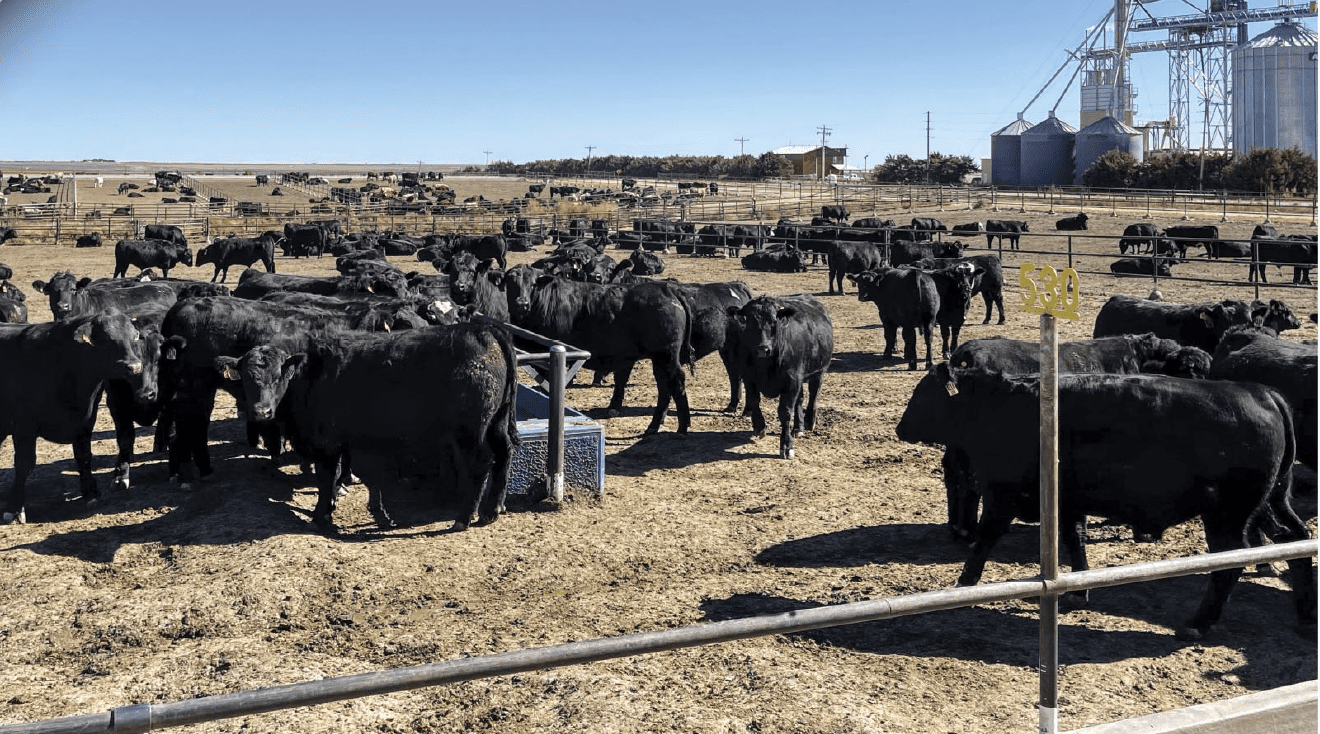

The beef industry has dedicated decades of research and capacity to addressing the bovine respiratory disease (BRD) complex through vaccine technologies, antibiotic therapies, and management; yet, feedyard mortality rates continue to rise, and BRD remains the most economically detrimental disease to the industry.[1]
The current estimated direct cost of BRD mortality to the beef industry is $907.8 million annually, and the average cost for BRD treatments for feedlots is $75 million,[1] with additional losses associated with decreased growth performance and reduced carcass quality.
Recent developments in the field of BRD research have shed light to focus on a more systemic approach to BRD management through prevention, particularly at the intestinal level.

The field of gastrointestinal health in humans and livestock has evolved rapidly over the past decade, with associations discovered between the interplay of the intestinal microbial population and environment and animal health and well-being.
In ruminant production, the impact that the post-ruminal intestinal tract has on animal health and performance is beginning to be acknowledged and more well understood.
The metabolic impact of the gastrointestinal tract in ruminants is significant as the surface area is vast and, depending on level of production, can range in size from 15,000 sq. ft. to 30,000 sq. ft., a tremendous space for the animal to defend and maintain.
The gastrointestinal tract houses over 70% of the immune system, is the hub for post-ruminal nutrient digestion, absorption, and transport, and represents approximately 20% of total body oxygen use and up to 30% of total metabolic and protein synthesis.[2]
This system is kept intact predominantly by the resident commensal microbial population.
To fulfill functional demands, the physical barrier of the tract is highly permeable, comprised of a single cellular epithelial layer along with mucosal and microbial layers.
The integrity of the mucosal layer is highly dependent on the commensal microbial population as these populations are responsible for facilitating production of the mucosal layer, strengthening tight junction proteins of the epithelial cells through short chain fatty acid production, and serving as a barrier to parasites, pathogens, toxins, and acids.
Compromise to this microbial population jeopardizes the efficacy of the intestinal barrier, leaving the tract and animal vulnerable to pathogen invasion and colonization.
Overwhelming the system leads to an uncontrolled flux of bacteria and luminal antigens, reduced absorptive efficiency, and an increased energy demand, a complex referred to as leaky gut.

Common management practices that result in acute or prolonged subacute stress impact the integrity of the intestinal tract.
The permeability and integrity of the gastrointestinal tract is vulnerable to dietary changes, low feed and water intake that occur during weaning and transition, antimicrobial use, sub-acute ruminal acidosis, and environmental challenges.[3,4,5]
Moreover, microbial ecosystems of individuals are dynamic and influenced at birth by vaginal microbial populations, dietary changes, environmental exposures, and management stressors.[6]
Individuals possessing more robust populations of commensal microbes, particularly in the lungs, have stronger lines of defense against pathogenic invasion associated with BRD in the forms of barrier function, improved immune function by microbial crosstalk, and production of metabolites that promote lung health.[7,8]
Further, in humans, pulmonary health has been associated with robust intestinal commensal microbial populations as the microbial communities of the lung are exposed to intestinal microbial populations and metabolites through the mesenteric lymph system.[9]
The major bacterial species involved in the BRD complex, Mannheimia haemolytica, Mycoplasma bovis, Pasteurella multocida, and Histophilus somni, produce virulent compounds like lipopolysacharide, a potent immune signal that triggers a strong inflammatory immune response.
Colonization of these species and the associated inflammatory processes that follow are detrimental to the commensal bacterial species and are energetically demanding, exacerbating treatment efficacy and prolonging production losses.
Immune cells are obligate glucose users upon activation.
During a lipopolysaccharide challenge to lactating dairy cows, the estimated glucose requirement to support the challenged immune system was more than 1 kg of glucose over a 12-hour period, and glucose infusion during the challenge did not reestablish milk production.[10]
Preventative measures that reduce colonization and repress virulence of BRD pathogens through promotion of intestinal health can lessen associated treatment and production losses.

Management of the BRD complex is challenging, continues to plague the beef industry, and persists largely due to the management structure of the US beef system and many others across the globe.
Antimicrobial therapies are presently the most common treatment regimens; however, long-term use continues to be scrutinized.
Considerations of the systemic effects of antimicrobial use at the microbial level should also be acknowledged as commensal bacterial populations are largely compromised by use and take time for re-establishment.
Emerging alternative methods for treatment and management of BRD, with an emphasis on a systematic approach, including targeted therapies and methods for enhancing immune function and intestinal health at the microbial level are evolving.
Particularly, the nutraceutical market is a self-regulated industry and has been heavily exploited in the livestock and human health sectors.
Skepticism with the efficacy of these compound types is derived by the sometimes-overwhelming claims and responses associated with these products.
Technologies in this arena continue to rapidly evolve; yet, owing to the development in knowledge of the intricate and dynamic roles the post-ruminal digestive tract has on health and productivity of the animal, developing an understanding of the application and science of these types of compounds has merit.

Evaluation of nutraceutical compounds should include the development of sound research, an understanding of the mode and site of action, the impacts of the compound on commensal microbial populations, compound stability in pelleting and processing conditions, liquid flowability and mixing, gastrointestinal stability, and interactions with antimicrobials.
The BRD complex will persist in beef and dairy production until market forces significantly drive alter native management practices.
Embracing alter native preventative technologies and practices that target intestinal health management may reduce the severity, incidence, and economic impact of BRD to the industry.
1.Peel, D. S. 2020. The effect of market forces on bovine respiratory disease. Vet Clin Food Anim 36:497-508.
2.Cant, J. P., B. W. McBride, and W. J. Croom Jr. 1996. Regulation of intestinal metabolism and its impact on whole animal energetics. J. Anim. Sci. 74:2541-2553.
3.Zhang, S., R. I. Albornoz, J.R. Aschenbach, D. R. Barreda, and G. B. Penner. 2013. Short-term feed restriction impairs the absorptive function of the reticulo-rumen and total tract barrier function in beef cattle. J. Anim. Sci. 91:1685-1695.
4.Wood, K. M., S. I. Palmer, M. A. Steele, J. A. Metcalf and G. B. Penner. 2015. The influence of age and weaning on permeability of the gastrointestinal tract in Holstein bull calves. J. Dairy Sci. 98:7226-7237.
5.Pederzolli, R. A., A. G. Van Kessel, J. Campbell, S. Hendrick, K.M. Wood, and G. B. Penner. 2018. Effect of ruminal acidosis and short-term low feed intake on indicators of gastrointestinal barrier function in Holstein steers. J. Anim. Sci. 96:108-125.
6.Credille, B. 2022. Modulation of the bovine respiratory microbiome from a systems perspective. Vet Clin Food Anim. 38:229-243.
7.Chase, C. and R. S. Kaushik. 2019. Mucosal Immune System of Cattle. Vet Clin Food Anim. 35:431-451.
8.Timsit, E., C. McMullen, S. Amat, and T.W. Alexander. 2020. Respiratory bacterial microbiota in Cattle from development to modulation to enhance respiratory health. Vet Clin Food Anim. 36:297-320.
9.Enaud, R., R. Prevel, E. Ciarlo, F. Beaufils, G. WieÎrs, Benoit Guery, and L. Delhaes. 2020. The gut-lung axis in health and respiratory diseases: a place for inter-organ and inter-kingdom crosstalks. Front. Cell. Infect. Microbiol. 10:9.
10.Kvidera, S. K., E. A. Horst, M. Abuajamieh, E. J. Mayorga, M. V. Sanz Fernandez, L. H. Baumgard. 2017. Glucose requirements of an activated immune system in lactating Holstein cows. J. Dairy Sci. 100:2360-2374.
 Sara Trojan is the owner of Peak Beef Nutrition and Management Consulting, LLC, a nutrition consulting business focusing on backgrounding, stocker, and cow/calf nutrition and management. Prior to the development of this busi ness, Sara was on faculty in beef cattle teaching and research positions at South Dakota State University for two years and Texas Tech University for five years and worked in technical service for industry. She earned a M.S. in Animal Science from Kansas State University in 2006 and a Ph.D. in Animal Nutrition from Oklahoma State University in 2009. Sara maintains strong relationships and involvement with industry and academic professionals and associations and is active in the operations of her family ranch near Sheridan, WY. She, her husband, and two daughters live in Casper, WY.
Sara Trojan is the owner of Peak Beef Nutrition and Management Consulting, LLC, a nutrition consulting business focusing on backgrounding, stocker, and cow/calf nutrition and management. Prior to the development of this busi ness, Sara was on faculty in beef cattle teaching and research positions at South Dakota State University for two years and Texas Tech University for five years and worked in technical service for industry. She earned a M.S. in Animal Science from Kansas State University in 2006 and a Ph.D. in Animal Nutrition from Oklahoma State University in 2009. Sara maintains strong relationships and involvement with industry and academic professionals and associations and is active in the operations of her family ranch near Sheridan, WY. She, her husband, and two daughters live in Casper, WY.
Get all Doc Talk episodes straight to your email inbox!